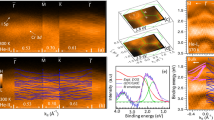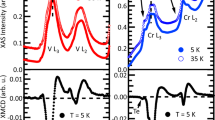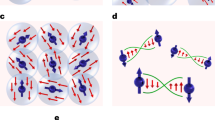Abstract
Dilute ferromagnetic oxides having Curie temperatures far in excess of 300 K and exceptionally large ordered moments per transition-metal cation challenge our understanding of magnetism in solids. These materials are high-k dielectrics with degenerate or thermally activated n-type semiconductivity. Conventional super-exchange or double-exchange interactions cannot produce long-range magnetic order at concentrations of magnetic cations of a few percent. We propose that ferromagnetic exchange here, and in dilute ferromagnetic nitrides, is mediated by shallow donor electrons that form bound magnetic polarons, which overlap to create a spin-split impurity band. The Curie temperature in the mean-field approximation varies as (xδ)1/2 where x and δ are the concentrations of magnetic cations and donors, respectively. High Curie temperatures arise only when empty minority-spin or majority-spin d states lie at the Fermi level in the impurity band. The magnetic phase diagram includes regions of semiconducting and metallic ferromagnetism, cluster paramagnetism, spin glass and canted antiferromagnetism.
This is a preview of subscription content, access via your institution
Access options
Subscribe to this journal
Receive 12 print issues and online access
$259.00 per year
only $21.58 per issue
Buy this article
- Purchase on Springer Link
- Instant access to full article PDF
Prices may be subject to local taxes which are calculated during checkout






Similar content being viewed by others
References
Prellier, W., Fouchet, A. & Mercey, B. Oxide-diluted magnetic semiconductors: a review of the experimental status. J. Phys. Condens. Matter 15, R1583–R1601 (2003).
Pearton, S. J. et al. Wide band gap ferromagnetic semiconductors and oxides J. Appl. Phys. 93, 1–13 (2003).
Dietl, T. et al. Zener model description of ferromagnetism in zinc-blende magnetic semiconductors. Science 287, 1019–1022 (2000).
Matsumoto, Y. et al. Room-temperature ferromagnetism in transparent transition metal-doped titanium dioxide Science 291, 854–856 (2001).
Ueda, K., Tabata, H. & Kawai, T. Magnetic and electric properties of transition-metal-doped ZnO films. Appl. Phys. Lett. 79, 988–990 (2001).
Ogale, S. B. et al. High temperature ferromagnetism with a giant magnetic moment in transparent Co-doped SnO2-δ . Phys. Rev. Lett. 91, 077205 (2003).
Kim, J. Y. et al. Ferromagnetism induced by clustered Co in Co-doped anatase TiO2 thin films Phys. Rev. Lett. 90, 017401 (2003).
Punnoose, A., Seehra, M. S., Park, W. K. & Moodera, J. S. On the room temperature ferromagnetism in Co-doped TiO2 films. J. Appl. Phys. 93, 7867–7869 (2003).
Rode, K. et al. Magnetic semiconductors based on cobalt substituted ZnO. J. Appl. Phys. 93, 7676–7678 (2003).
Ramachandran, S., Tiwari, A. & Narayan, J. Zn0.9Co0.1O-based diluted magnetic semiconducting thin films. Appl. Phys. Lett. 84, 5255–5257 (2004).
Goodenough, J. B. Magnetism and the Chemical Bond (Interscience, New York, 1963).
Holtzberg, F., von Molnar, S. & Coey, J. M. D. Handbook on Semiconductors Vol. 3 (ed. Keller, S.) 850 (North Holland, Amsterdam, 1980).
Dietl, T. Ferromagnetic semiconductors. Semicond. Sci. Technol. 17, 377–392 (2002).
Mott, N. F. Conduction in Noncrystalline Materials (Oxford Univ. Press, Oxford, 1987).
von Molnar, S. & Kasuya, T. in Proceedings of 10th International Conference on Physics of Semiconductors (eds Keller, S. P., Hensel, J. C. & Stern, F.) 233 (U.S.A.E.C. Division of Technical Information, Springfield, Vancouver, 1970).
Dietl, T. & Spalek, J. J. Effect of thermodynamic fluctuations of magnetization on the bound magnetic polaron in dilute magnetic semiconductors. Phys. Rev. B 28, 1548–1563 (1983).
Wolff, P. A. Semiconductors and Semimetals Vol. 25 (eds Furdyna, J. R. & Kossut, J.) (Academic, San Diego 1988).
Angelescu, D. E. & Bhatt, R. N. Effective interaction Hamiltonian of polaron pairs in diluted magnetic semiconductors. Phys. Rev. B 65, 075211 (2002).
Durst, A. C., Bhatt, R. N. & Wolff, P. A. Bound magnetic polaron interactions in insulating doped diluted magnetic semiconductors. Phys. Rev. B 65, 235205 (2002).
Zallen, R. M. Physics of Amorphous Solids (Wiley, New York, 1983).
Kaminski, A. & Das Sarma, S. Polaron percolation in diluted magnetic semiconductors. Phys. Rev. Lett. 88, 247202 (2002).
Kasuya, T. Mobility of antiferromagnetic large polaron. Solid State Commun. 8, 1635 (1970).
Kim, K. J. & Park, Y. R. Spectroscopic ellipsometry study of optical transitions in Zn1-xCoxO alloys. Appl. Phys. Lett. 81, 1420–1422 (2002).
Berciu, M. & Bhatt, R. N. Effects of disorder on ferromagnetism in diluted magnetic semiconductors. Phys. Rev. Lett. 87, 107203 (2001).
Das Sarma, S., Hwang, E. W. & Kaminski, A. Temperature-dependent magnetization in diluted magnetic semiconductors. Phys. Rev. B 67, 155201 (2003).
Wilson, J. A. Systematics of breakdown of Mott insulation in binary transition-metal compounds. Adv. Phys. 21, 143 (1972).
Saeki, H., Tabata, H. & Kawai, T. Magnetic and electric properties of vanadium doped ZnO films. Solid State Commun. 120, 439–443 (2001).
Hong, N.Y H., Sakai, J. & Hassini, A. Ferromagnetism at room temperature with a large magnetic moment in anatase V- doped TiO2 thin films. Appl. Phys. Lett. 84, 2602–2604 (2004).
Venkatesan, M., Fitzgerald, C. B. & Coey, J. M. D. Unexpected magnetism in a dielectric oxide. Nature 430, 630–630 (2004).
Mattis, D. C. Theory of Magnetism Vol. 1 (Springer, Berlin, 1981).
Yahia, J. Dependence of electrical conductivity and thermoelectric power of pure and aluminium-doped rutile on equilibrium oxygen pressure and temperature. Phys. Rev. 130, 1711–1719 (1963).
Kohan, A. F., Ceder, G., Morgan, D. & Van de Walle, C. G. First-principles study of native point defects in ZnO. Phys. Rev. B 61, 15019–15027 (2000).
Stoneham, A. M. Theory of Defects in Solids Ch. 16 (Clarendon, Oxford 1975).
Sonoda, S., Shimizu, S., Sasaki, T., Yamamoto, Y. & Hori, H. Moleclar beam epitaxy of wurtzite (Ga,Mn)N films on sapphire (0001) showing the ferromagnetic behaviour at room temperature. J. Cryst. Growth 237, 1358–1362 (2002).
Hashimoto, M., Zhou, Y. K., Kanamura, M. & Asahi, H. High-temperature (>400K) ferromagnetism in III-V based diluted magnetic semiconductor GaCrN grown by ECR molecular-beam epitaxy. Solid State Commun. 122, 37–39 (2002).
Wu, S. Y. et al. Synthesis, Characterization and modeling of high-quality ferromagnetic Cr-doped AlN thin films. Appl. Phys. Lett. 82, 3047–3049 (2003).
Shinde, S. R. et al. Ferromagnetism in laser-deposited anatase Ti1-xCoxO2-δ films. Phys. Rev B 67, 115211 (2003).
Wang, Z. J., Tang, J. K., Tung, L. D., Zhou, W. L. & Spinu, L. Ferromagnetism and transport properties of Fe-doped reduced-rutile TiO2-δ films. J. Appl. Phys. 93, 7870–7872 (2003).
Coey, J. M. D., Douvalis, A. P., Fitzgerald, C. B. & Venkatesan, M. Ferromagnetism in Fe-doped SnO2 films. Appl. Phys. Lett. 84, 1332–1334 (2004).
Sharma, P. et al. Ferromagnetism above room temperature in bulk and transparent thin films of Mn-doped ZnO. Nature Mater. 2, 673–677 (2003).
Han, S. J. et al. Magnetism in Mn-doped ZnO bulk samples prepared by solid-state reaction. Appl. Phys. Lett. 83, 920–922 (2003).
Radovanovic, P. V. & Gamelin, D. R. High-temperature ferromagnetism in Ni2+-doped ZnO aggregates prepared from colloidal diluted magnetic semiconductor quantum dots. Phys. Rev. Lett. 91, 157202 (2003).
Kale, S. N. et al. Magnetism in cobalt-doped Cu2O thin films without and without Al, V and Zn codopants. Appl. Phys. Lett. 83, 2100–2102 (2003).
Philip, J., Theodoropolou, N., Berera, G., Moodera, J. S. & Satpati, B. High-temperature ferromagnetism in manganese-doped indium-tin oxide films. Appl. Phys. Lett. 85, 777–779 (2004).
Acknowledgements
This work was supported by Science Foundation Ireland as part of the CINSE project. The authors are grateful to James Lunney, Sebastiaan van Dijken, Stefano Sanvito and Plamen Stamenov for their helpful comments.
Author information
Authors and Affiliations
Corresponding author
Ethics declarations
Competing interests
The authors declare no competing financial interests.
Rights and permissions
About this article
Cite this article
Coey, J., Venkatesan, M. & Fitzgerald, C. Donor impurity band exchange in dilute ferromagnetic oxides. Nature Mater 4, 173–179 (2005). https://doi.org/10.1038/nmat1310
Received:
Accepted:
Published:
Issue Date:
DOI: https://doi.org/10.1038/nmat1310
This article is cited by
-
Enhanced Ferromagnetism in Nano-sized Sn0.85Co0.10Fe0.03Mn0.02O2 Dilute Magnetic Semiconductor Synthesised by Sol–Gel Method
Journal of Superconductivity and Novel Magnetism (2024)
-
Ferromagnetic, Optical and Photoluminescence Behavior of Ni-Doped ZnO Thin Films
Topics in Catalysis (2024)
-
Tunable rectification and magnetoresistance behaviors of ferromagnetic pn diode based on (Fe, Al)-doped SiGe with enhanced room-temperature magnetization
Science China Materials (2024)
-
Microstructure mediated weak ferromagnetism in La-doped CeO2 nanoparticles
Applied Physics A (2024)
-
Defects mediated weak ferromagnetism in Zn1−yCyO (0.00 ≤ y ≤ 0.10) nanorods semiconductors for spintronics applications
Scientific Reports (2023)



